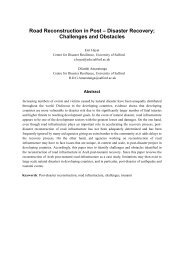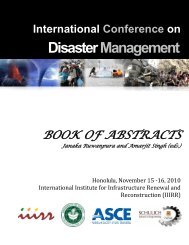Alternative resilient livelihood option for fisher-folks tsunami victims
Alternative resilient livelihood option for fisher-folks tsunami victims
Alternative resilient livelihood option for fisher-folks tsunami victims
You also want an ePaper? Increase the reach of your titles
YUMPU automatically turns print PDFs into web optimized ePapers that Google loves.
Table 2: Growth, survival and production of crabs in the first farming cycle<br />
% of<br />
# of # of % of Avg. wt at Avg. wt at Avg. wt<br />
Cage #<br />
wt.<br />
stocked Harvested Survival stocking(g) Harvesting(g) gained<br />
gain<br />
C 1 10 10 100 540 915 375 69.44<br />
C 2 10 7 70 580 945 365 62.93<br />
C 3 10 8 80 740 1299 559 75.54<br />
C 4 10 10 100 600 1024 424 70.66<br />
C 5 10 9 90 475 825 350 73.68<br />
In this experiment, individual weight gained during fattening was 414.6 gms <strong>for</strong> crabs weighing<br />
587gms. These growth increments were seem to be very high in comparison with other studies done<br />
by Bensam, (1986), who recorded average monthly increments of 80- 162 gms <strong>for</strong> crabs of initially<br />
weighing 50 gms. Feeding was not a problem during the fattening period because all the crab feed<br />
employed such as trash fish, fine pieces of chicken gut wastes, shrimp heads, fish offal and kitchen<br />
leftovers were well accepted. The all Feed Consumption Rate (FCR) values <strong>for</strong> all cages showed<br />
values greater than one (Table 3).<br />
Table 3: Feed consumption and Feed Conversion Ratio (FCR) <strong>for</strong> the first farming cycle<br />
Cage # Total wt. of feed provided(kg) Total wt. gained(kg) FCR(on wet weight basis)<br />
C 1 16.275 3.570 4.56:1<br />
C 2 14.210 1.925 7.38:1<br />
C 3 15.440 2.352 6.56:1<br />
C 4 16.870 3.150 5.35:1<br />
C 5 14.940 2.412 6.19:1<br />
Maintenance costs of floating crab cages are minimal compared to the fish cages. The crawling of<br />
crabs along the wooden poles or side nettings of the cages helps to reduce fouling. Except <strong>for</strong><br />
attached seaweeds, there is no fouling by barnacles or other organisms. Such organisms probably<br />
serve as an alternative food source <strong>for</strong> the crab.<br />
The net profit of the operation was SL Rs.6388.00 per cage (Table 4). At the same time in our crab<br />
fattening programme the beneficiaries were provided with a wooden crab cage costs, Rs.2650.00<br />
and 10 watery crabs with costs of Rs.3000.00. Through the first farming cycle they obtained<br />
Rs.5650.00 per cage additionally. This amount of money is enough to establish another cage with<br />
watery crabs to continue the next fattening cycle. If one could run about maximum of 10 fattening

















